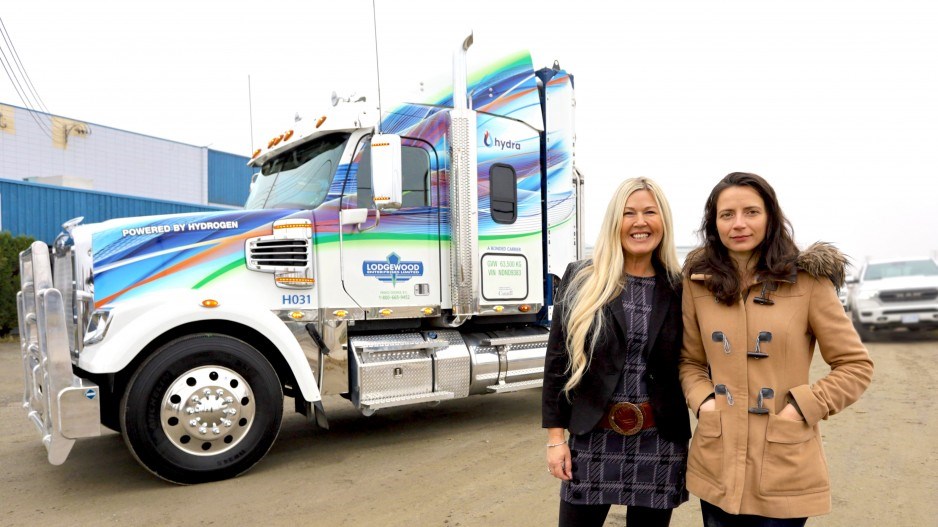On a five-acre lot on the outskirts of Prince George sits a potential sneak preview of what’s ahead for much of Canada’s trucking industry.
There, Jessica Verhagen envisions three fuelling pumps dispensing her company’s hydrogen – plus diesel from a third-party provider – for a fleet of 65 semi-trailer trucks all within 10 minutes.
“In terms of bang for your buck on greenhouse gas emission reductions, it really makes sense to go after these heavy-duty fleets and provide them with some cost-effective options to get ahead of the curve,” the CEO of Hydra Energy Corp. told BIV while visiting Prince George for city council hearings on rezoning the five-acre site.
Hydra specializes in hydrogen-diesel co-combustion conversion kits for companies looking to wean their fleets of medium- and heavy-duty vehicles (MHDVs) from gasoline and diesel.
The Delta startup has so far raised $22 million from investors and has signed deals with partners intrigued by the prospect of reducing emissions by up to 40 per cent with retrofitted fleets capable of running on a blend of hydrogen and diesel as far as 1,000 kilometres.
The Prince George rezoning hearings for Hydra’s multimillion-dollar plant come within weeks of Ottawa embarking on a new 2030 Emissions Reduction plan mandating significant cuts in emissions from all industries. While the feds require zero-emissions vehicles (ZEVs) to make up 100 per cent of sales for new passenger vehicles by 2035, industries reliant on MHDVs face significant challenges despite goals less demanding than those for regular consumers.
Instead of an outright mandate, the government “will aim to achieve 35 per cent of total MHDV sales being ZEVs by 2030,” according to the 2030 Emissions Reduction plan. The plan would require 100 per cent of MHDV sales to be ZEVs by 2040 for what it describes as a “subset of vehicles.”
“It’s feasible, but there’s a lot of work to do,” said ZEV expert Matthew Klippenstein, a regional manager with the Canadian Hydrogen and Fuel Cell Association.
“Truckers had a really bad experience with the vaunted new technology of 10 years ago: natural gas combustion. It was the trucking industry’s version of the Phoenix payroll system problem in Ottawa. It’s not enough for someone to fill out a spreadsheet and say, ‘Lower total cost of ownership; it’s a cinch.’ We need to earn the trust of people who depend on these vehicles for their livelihoods.”
Ottawa is offering a $550 million purchase incentive program for MHDVs as well as $200 million for retrofitting large trucks.
“We’ll work with these amounts now, see how far we can get in a couple years and recalibrate as necessary,” Klippenstein said.
The Canadian Trucking Alliance, meanwhile, said significant innovations are still going to be necessary to make this plan viable.
“The challenge our sector faces, particularly the long-haul portion of the industry, are technology barriers preventing the introduction of alternatives to the diesel engine,” CTA president Stephen Laskowski said in a statement.
There are also significant infrastructure barriers facing efforts to shift more MHDVs towards ZEVs.
The proposed Prince George Hydra plant would be capable of dispensing 3,000 kilograms of hydrogen per day, which the company claims would make it the largest hydrogen refuelling station in the world.
But public refuelling stations remain sparse for now in Canada, with B.C. serving as home to the vast majority: five.
Ottawa is supporting the construction of 19 more across Canada, but that figure is still greatly outnumbered by investments in public electric vehicle (EV) charging stations.
Canada is home to close to 7,000 public EV stations and the latest federal budget has earmarked $400 million towards building out more ZEV infrastructure, including 50,000 charging stations.
While EV infrastructure is set to expand significantly, that may still pose challenges for sectors reliant on MHDVs as businesses debate whether to go electric or tap hydrogen.
A battery pack for some models of electric semi-trucks can weigh in at more than 3,500 kilograms, significantly increasing the payload, while at the same time still facing range limits before a recharge is necessary.
Hydra’s conversion kits, which cost $55,000 with installation, would increase a truck’s payload by 740 kilograms, according to Verhagen.
“I do think EVs have a huge role to play – I just don’t think it’s one solution for everything across the board for transportation,” she said.




